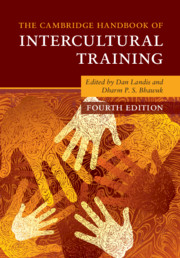Book contents
- The Cambridge Handbook of Intercultural Training
- Reviews
- The Cambridge Handbook of Intercultural Training
- Copyright page
- Dedication
- Frontispiece
- Contents
- Figures
- Tables
- Editors and Contributors
- Foreword
- Preface
- 1 Introduction and Theoretical Framework
- Part I Theoretical Foundations of Intercultural Training
- Part II Practice of Intercultural Training
- 10 International Initiatives in K–12 and Higher Education
- 11 The Triad Training Model in Counseling, Cultural Diversity, and Intercultural Training
- 12 Multicultural Counseling Training and Intercultural Training
- 13 Training for Cross-Cultural Competence in the United States Military
- 14 Developing Intercultural Competency Training in Global Organizations
- Part III Indigenous Psychology and Intercultural Training
- Part IV New Interdisciplinary Approaches to Intercultural Training
- Part V Summing Up
- Index
- References
12 - Multicultural Counseling Training and Intercultural Training
A Synthesis
from Part II - Practice of Intercultural Training
Published online by Cambridge University Press: 18 September 2020
- The Cambridge Handbook of Intercultural Training
- Reviews
- The Cambridge Handbook of Intercultural Training
- Copyright page
- Dedication
- Frontispiece
- Contents
- Figures
- Tables
- Editors and Contributors
- Foreword
- Preface
- 1 Introduction and Theoretical Framework
- Part I Theoretical Foundations of Intercultural Training
- Part II Practice of Intercultural Training
- 10 International Initiatives in K–12 and Higher Education
- 11 The Triad Training Model in Counseling, Cultural Diversity, and Intercultural Training
- 12 Multicultural Counseling Training and Intercultural Training
- 13 Training for Cross-Cultural Competence in the United States Military
- 14 Developing Intercultural Competency Training in Global Organizations
- Part III Indigenous Psychology and Intercultural Training
- Part IV New Interdisciplinary Approaches to Intercultural Training
- Part V Summing Up
- Index
- References
Summary
While Multicultural Counseling Training (MCT) and Intercultural Training (ICT) represent two prominent, culture-focused specialties that concern with cultural, intercultural, and human diversity issues, there have been surprisingly little to no intersections or interactions between the two disciplines up to this point. To bridge this gap, the current chapter offers a comprehensive and synergetic review of MCT and its relevance and implication for ICT. Accordingly, the present chapter systematically surveys and analyzes: (1) MCT’s historical roots and development; (2) its parallels and similarities to ICT; (3) the definition of multicultural counseling practice and training; (4) the advent of professional standards for MCT; (5) MCT’s operationalization and measurement of cultural competence; (6) its training models, methods, and techniques; and (7) the prevailing and emerging themes and issues of MCT. In this review, striking parallels and intriguing divergences between MCT and ICT are identified, juxtaposed, and examined, from their respective historical, sociopolitical, intellectual, and methodological traditions and contexts. Critical thoughts and recommended directions to encourage a greater intellectual cross-fertilization and interdisciplinary collaboration between the two specialty areas are considered and presented. As follows, this integrative review represents among the first systematic attempts to facilitate the linkage and the synthesis between these two eminent, allied disciplines.
Keywords
- Type
- Chapter
- Information
- The Cambridge Handbook of Intercultural Training , pp. 407 - 439Publisher: Cambridge University PressPrint publication year: 2020



